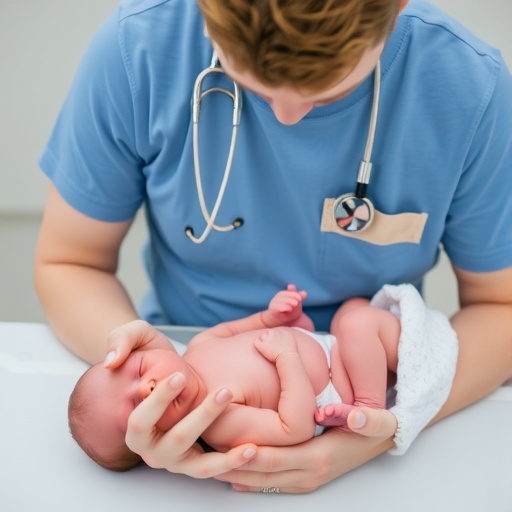
In the delicate moments immediately following birth, the transition from fetal to neonatal life is one of the most critical phases a human being experiences. Central to ensuring a newborn’s survival in cases of distress is the timely initiation of resuscitation efforts, including ventilation and chest compressions. Current neonatal resuscitation guidelines recommend starting chest compressions if the infant’s heart rate remains below 60 beats per minute after 30 seconds of effective ventilation. Yet, this threshold, though widely accepted, is based primarily on expert consensus and limited experimental data—leaving a significant gap in robust clinical evidence. A new comprehensive narrative review, recently published in the Journal of Perinatology, revisits the validity of this longstanding guideline, calling for a deeper scientific interrogation of when chest compressions should truly begin during neonatal bradycardia.
The review, led by researchers Binkhorst, van Elsäcker, Matthijsse, and their colleagues, scrutinizes the available literature up to March 2024, encompassing animal studies, in vitro experiments, mathematical modeling, and human observational data. Their effort follows an earlier scoping review that aggregated knowledge until late 2021, but this latest work zooms in specifically on the heart rate thresholds dictating the initiation of chest compressions. Despite a comprehensive search through major databases such as MEDLINE, Embase, and the Cochrane Library, no direct clinical trials comparing different heart rate thresholds for starting chest compressions in newborns at birth were discovered. This absence points to an urgent need for fresh research paradigms in neonatal resuscitation.
Understanding the physiological mechanisms underlying neonatal bradycardia—slow heart rate—is pivotal to interpreting why the 60 bpm cutoff became standard and whether it remains appropriate. Bradycardia in the newborn is most commonly a manifestation of inadequate oxygenation and ventilation, often compounded by delayed or ineffective respiratory efforts. The heart rate drop reflects a systemic response to hypoxia, where the heart rate falls as oxygen saturation plummets, necessitating immediate intervention to restore adequate oxygen delivery to vital organs, especially the brain. The review elaborates on intricate cardiovascular adjustments at birth, emphasizing that these adaptive mechanisms might tolerate heart rates slightly below 60 bpm without immediate harm, provided ventilation is effective and oxygen delivery improves.
In vitro studies and animal models—primarily involving lambs and piglets as proxies for human neonates—offer controlled environments to explore cardiovascular responses to asphyxia and resuscitation strategies. Such experiments have illuminated that the timing and effectiveness of ventilation dramatically influence heart rate recovery, sometimes more so than chest compressions initially. These models illustrate that premature initiation of chest compressions might not only be unnecessary but could potentially disrupt the carefully orchestrated physiological processes engaged during neonatal adaptation. Importantly, the review discusses emerging mathematical models from the authors’ own research center, which simulate neonatal cardiovascular dynamics and support the hypothesis that delaying compressions beyond 30 seconds of ventilation might be beneficial in specific heart rate ranges.
One of the most striking components of the study involved a global survey disseminated among neonatal clinicians and researchers, numbering 183 respondents. Approximately 75% of these experts expressed a preference for waiting longer than the current 30-second recommendation before commencing chest compressions when encountering a heart rate between 30 and 60 bpm, assuming effective ventilation was in progress. This majority viewpoint underscores a clinical tension: the balance between not delaying chest compressions unnecessarily and avoiding premature chest compressions that could be non-beneficial or harmful. The consensus suggests a growing recognition in the neonatal care community that the rigid application of the 60 bpm threshold may lack nuance and that increasingly sophisticated decision algorithms could improve outcomes.
Historical context provides further insight into why the current guidelines were established, mainly derived from expert panel consensus informed by limited experimental evidence. The neonatal resuscitation program (NRP) guidelines have prioritized rapid responses due to the urgency inherent in neonatal asphyxia. However, this new review challenges the orthodoxy by weaving together physiological, experimental, and clinical insights to argue for a reconsideration of the heart rate cutoff. The authors emphasize that the evidence base, to date, does not robustly delineate a strict “red line” for initiating compressions but rather implies that a more individualized approach considering ventilation quality and heart rate trends could be superior.
This reassessment carries profound implications for clinical practice worldwide. Should chest compressions be delayed past 30 seconds in certain bradycardic infants, provided that ventilation is effective and heart rate shows an upward trajectory? The answer could reshape neonatal resuscitation protocols, potentially reducing unnecessary compressions that may increase neonatal morbidity or complicate management. Chest compressions are not benign; they require synchronization with ventilation and carry risks of trauma and hemodynamic instability, especially in the fragile, premature, or compromised newborn.
Moreover, the review highlights the pressing need for high-quality randomized controlled trials (RCTs) and well-designed animal studies that specifically compare different heart rate thresholds and timing for chest compression initiation. Such trials would help define optimal resuscitation algorithms grounded in physiological reality and evidence rather than tradition or expert opinion alone. Until then, neonatal practitioners operate in a zone of uncertainty, balancing recommendations with their clinical judgment, experience, and contextual factors at the bedside.
The review also touches upon technological advancements that may influence future resuscitation strategies. Innovations in real-time heart rate monitoring, oxygen saturation measurements, and simulation-based training could facilitate more precise and responsive decision-making during neonatal resuscitation. As these tools become better integrated into delivery room settings, tailored interventions respecting individual physiological responses may supplant one-size-fits-all thresholds. This personalized medicine approach could prove revolutionary in optimizing outcomes in the critical first few minutes of life.
Beyond the physiological and clinical dimensions, this debate has ethical and educational consequences. Training programs for neonatal resuscitation must adapt to evolving evidence, ensuring that future healthcare providers are equipped with the best knowledge to make life-saving decisions. Ethical considerations arise when balancing risks versus benefits in extremely vulnerable populations, particularly when evidence is limited. The review’s findings urge transparency and continuous reevaluation in guideline development, fostering a dynamic culture of evidence-based neonatal care.
In summation, the narrative review authored by Binkhorst and colleagues represents a pivotal stimulus for rethinking a foundational neonatal resuscitation parameter. By meticulously appraising the evidence—and highlighting its gaps—the authors make a compelling case for revisiting the 60 bpm heart rate threshold for initiating chest compressions. Their work urges the neonatal care community to prioritize research to clarify optimal timing, ensuring interventions at birth are both timely and physiologically justified to enhance newborn survival and long-term health.
As neonatal mortality and morbidity remain significant global challenges, even small modifications in resuscitation strategies hold immense potential to save lives. The insights offered by this review may pave the way for revisited protocols that better align with the complex cardiovascular transitions newborns undergo at birth. Physicians, neonatologists, researchers, and guideline committees alike must heed these findings and collaborate to propel neonatal care forward with evidence-driven precision.
In the near future, we anticipate that a new generation of studies—including rigorous clinical trials and sophisticated neonatal animal models—will elucidate the nuanced interplay between heart rate, ventilation, and chest compressions. Until then, the balance between caution and urgency in neonatal resuscitation remains delicate but crucial. This scientific reevaluation challenges entrenched practices and invites a paradigm shift informed by rigorous data, expert consensus, and technological innovation aimed at guarding life in humanity’s earliest and most vulnerable moments.
Subject of Research: Thresholds for initiating chest compressions in newborns with bradycardia at birth
Article Title: Threshold to initiate chest compressions for bradycardia at birth: A narrative review
Article References:
Binkhorst, M., van Elsäcker, E., Matthijsse, R.P. et al. Threshold to initiate chest compressions for bradycardia at birth: A narrative review. J Perinatol (2025). https://doi.org/10.1038/s41372-025-02320-2
Image Credits: AI Generated
DOI: https://doi.org/10.1038/s41372-025-02320-2
Tags: chest compressions initiation timingclinical evidence gaps in neonatal careeffective ventilation techniques for infantsexpert consensus on resuscitationheart rate thresholds for infantsJournal of Perinatology findingsliterature review on bradycardia in newbornsnarrative review on chest compressionsneonatal life transition challengesneonatal resuscitation guidelinesnewborn bradycardia managementresuscitation efforts in newborns





